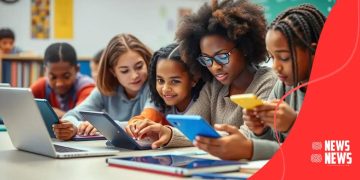Neurodiversity in the classroom: embracing different learning styles

Creating a supportive classroom environment involves clear expectations, open communication, positive relationships, and embracing diverse learners to enhance engagement and foster a safe, inclusive space for all students.
Neurodiversity in the classroom invites educators to rethink traditional teaching methods. Have you ever considered how different brains learn in unique ways? Let’s dive into this topic.
Understanding neurodiversity and its importance
Understanding neurodiversity is crucial for creating inclusive educational environments. It refers to the natural variation in human brains, recognizing that everyone processes information differently. Embracing this concept allows educators to tailor their teaching approaches.
The significance of neurodiversity
Neurodiversity is important because it highlights the strengths and challenges faced by individuals with different neurological conditions. Recognizing these differences promotes a supportive atmosphere.
Benefits of embracing neurodiversity
Incorporating neurodiversity in classrooms can lead to:
- Enhanced creativity and problem-solving skills among students.
- A deeper understanding of personal learning preferences and strengths.
- A more collaborative learning environment that values all contributions.
When teachers acknowledge various learning experiences, they foster a sense of belonging. Each student can thrive when their unique perspectives are valued. Fostering an understanding of neurodiversity can also enhance peer relationships, as students learn to appreciate differences.
Effective teaching practices involve adaptive methods that cater to varying needs. Whether through visual aids, hands-on activities, or social stories, these strategies recognize that neurodiverse learners benefit from personalized learning experiences. It’s essential for educators to continuously educate themselves on the challenges faced by these students.
By focusing on neurodiversity, schools can prepare students for a diverse world. Understanding and appreciating neurological differences contribute to a more empathetic society.
Different learning styles in the classroom
Different learning styles in the classroom play a significant role in how students engage with material. Each student has a unique way of absorbing information, which can enhance their learning experience. Understanding these styles helps educators cater to individual needs.
Types of learning styles
Some common learning styles include:
- Visual learners: Prefer to see information represented graphically.
- Auditory learners: Benefit from listening to lectures and discussions.
- Kinesthetic learners: Learn best through hands-on activities.
- Reading/writing learners: Favor learning through reading and writing tasks.
Each style can be leveraged to create a richer educational experience. For instance, visual learners may excel when using charts or videos, while auditory learners might thrive during group discussions.
It’s essential for teachers to incorporate diverse teaching methods in their classrooms. Doing so engages students with varying backgrounds and learning preferences. Adapting lessons to include visual aids, group work, and practical activities creates a dynamic learning environment.
Strategies for accommodating learning styles
To effectively support different learning styles, educators can:
- Incorporate multimedia resources to appeal to visual learners.
- Use storytelling and discussions to engage auditory learners.
- Design hands-on projects for kinesthetic learners.
- Encourage writing assignments for reading/writing learners.
Utilizing these strategies not only aids students but also fosters a sense of belonging in the classroom. Students who recognize their learning styles feel empowered to participate actively.
Ultimately, recognizing and accommodating different learning styles leads to improved educational outcomes. By valuing these differences, teachers promote a more inclusive and effective learning atmosphere.
Strategies for inclusive teaching practices

Inclusive teaching practices are essential for creating an environment where all students can thrive. Implementing effective strategies ensures that every student feels valued and supported. By integrating various methods, educators can accommodate the needs of neurodiverse students and those with different learning styles.
Engaging all students
One of the main strategies is to engage students through multiple forms of learning. Classrooms can benefit from a mix of audiovisual materials, interactive lessons, and collaborative activities. This variety keeps learning exciting and caters to different preferences.
Use of flexible grouping
Another efficient method is flexible grouping. Students can work in pairs or small groups based on shared interests or complementary skill levels. Grouping allows students to learn from each other, fostering collaboration and understanding.
In any classroom, learning styles vary significantly. To support this diversity, educators should adapt their instructional approaches. This may include:
- Using graphic organizers for visual learners.
- Incorporating discussion periods for auditory learners.
- Offering hands-on activities for kinesthetic learners.
- Allowing written reflections for reading/writing learners.
Creating a safe space for asking questions is also vital. When students feel comfortable expressing confusion, they engage more deeply. Incorporating feedback sessions can guide instruction and provide clarity. Providing ample opportunities for practice ensures that every student has a chance to excel.
Incorporating technology
Technology can significantly enhance inclusive practices. Educational apps and platforms support various learning styles, making materials more accessible. Online resources, videos, and interactive software can capture students’ attention and cater to their interests.
Ultimately, the goal is to promote a classroom culture that celebrates differences. By employing these strategies, educators can create an environment where every student is motivated to learn and grow.
Benefits of embracing diverse learners
Embracing diverse learners in the classroom brings numerous benefits that enhance the educational experience. Recognizing the unique strengths of each student not only fosters inclusivity but also enriches the overall learning environment.
Enriched classroom discussions
When diverse learners are included, classroom discussions become more dynamic. Each student brings different perspectives based on their backgrounds and experiences. Engaging with these varied viewpoints encourages critical thinking and open-mindedness. Students learn to appreciate differences, which is vital for personal growth.
Improved social skills
Interacting with a diverse group helps students develop better social skills. They learn how to communicate effectively with peers from different backgrounds. This collaboration builds empathy and respect, preparing them for a multicultural world.
Additionally, diverse classrooms encourage teamwork. Students learn to work together, drawing on each other’s strengths to achieve common goals. This collaborative spirit enhances problem-solving abilities and promotes a sense of belonging.
Enhanced creativity and innovation
Diverse learners contribute to increased creativity and innovation in the classroom. When students are exposed to various ideas and approaches, they are more likely to think outside the box. This creative synergy leads to unique solutions and projects, benefiting all students.
Moreover, educators can implement diverse teaching methods tailored to different learning styles. This personalized approach can result in improved academic performance. When students feel understood and supported, they are more motivated to engage in their studies.
Preparation for real-world challenges
Embracing diverse learners prepares students for the challenges of the real world. They develop skills necessary to navigate diverse workplaces and communities. Understanding how to collaborate with individuals from various backgrounds is a key asset in today’s global society.
Overall, the benefits of embracing diverse learners are clear. Acknowledging and valuing these differences transforms the educational experience, making it richer and more rewarding for everyone involved.
Creating a supportive classroom environment
Creating a supportive classroom environment is essential for fostering learning and growth. A positive atmosphere allows students to feel safe and valued, which enhances their ability to engage and participate. When students sense that their contributions matter, they are more likely to take risks in their learning.
Establishing clear expectations
One key aspect is establishing clear expectations for behavior and academic performance. When students understand what is expected of them, they feel more secure. Teachers can achieve this by setting rules collaboratively with the class, ensuring that everyone has a voice.
Encouraging open communication
Another important factor is encouraging open communication. When students feel comfortable sharing their thoughts and feelings, it fosters a sense of belonging. Teachers should create opportunities for students to express themselves, whether through discussions, suggestions, or even anonymous feedback. This practice helps address any concerns early on and builds trust.
Additionally, incorporating regular check-ins can help gauge how students are feeling. Simple gestures like asking about their day or feelings can make a big difference. Acknowledging their emotions creates a supportive atmosphere, demonstrating that their well-being is a priority.
Building positive relationships
Building positive relationships among students and between teachers and students is crucial. Group activities and partner work can help students connect with one another. When they collaborate on projects, they learn to appreciate each other’s strengths and perspectives. This teamwork fosters respect and empathy.
Moreover, teachers can support students by recognizing their individual strengths and challenges. Celebrating achievements, no matter how small, reinforces a positive environment. Encouragement and praise help students feel confident and motivated to succeed.
Creating an inclusive space
Finally, having a physically and emotionally inclusive classroom space is vital. The classroom should reflect diversity through decorations, resources, and books. Students should see themselves represented in materials and discussions. This representation fosters a sense of belonging and acceptance.
In conclusion, a supportive classroom environment is fundamental to student success. By establishing expectations, encouraging communication, building relationships, and promoting inclusivity, teachers create an ideal setting for all learners to thrive.
In summary, creating a supportive classroom environment leads to better learning for all students. By establishing clear expectations, encouraging open communication, and building positive relationships, educators help students feel safe and valued. Embracing diverse learners enhances collaboration and enriches discussions, fostering a culture of respect and empathy. Ultimately, when students feel included and understood, they thrive academically and socially, preparing them for a successful future.
FAQ – Frequently Asked Questions about Creating a Supportive Classroom Environment
Why is it important to have clear expectations in the classroom?
Clear expectations help students understand what is expected of them, creating a secure environment where they can thrive.
How can I encourage open communication with my students?
You can encourage open communication by creating opportunities for students to share their thoughts and feelings, such as through discussions and feedback sessions.
What are some effective ways to build positive relationships in the classroom?
Building positive relationships can be achieved through group activities, recognizing individual strengths, and celebrating achievements.
How does embracing diverse learners benefit the classroom environment?
Embracing diverse learners enhances collaboration, enriches discussions, and fosters a culture of respect and empathy among all students.





